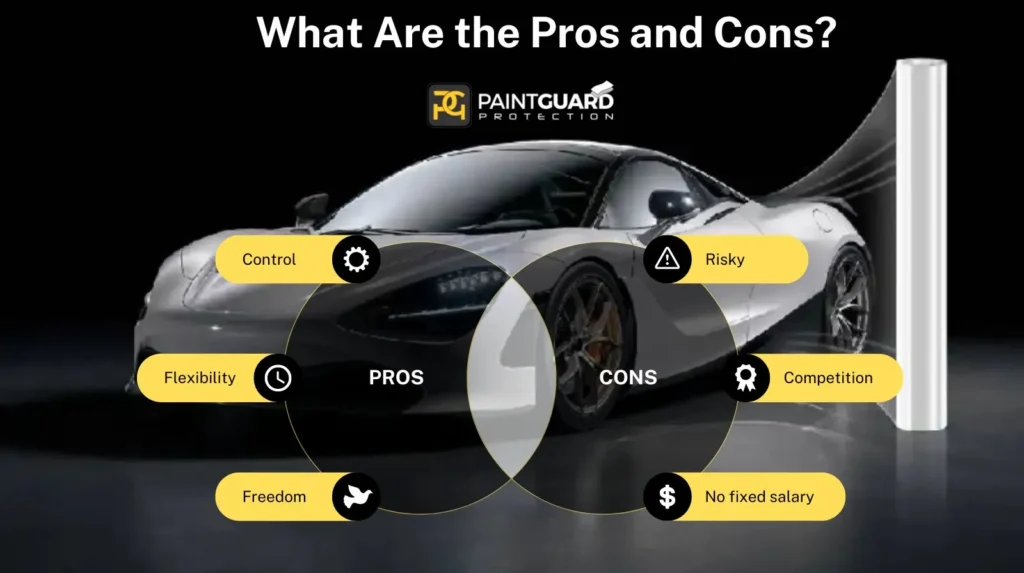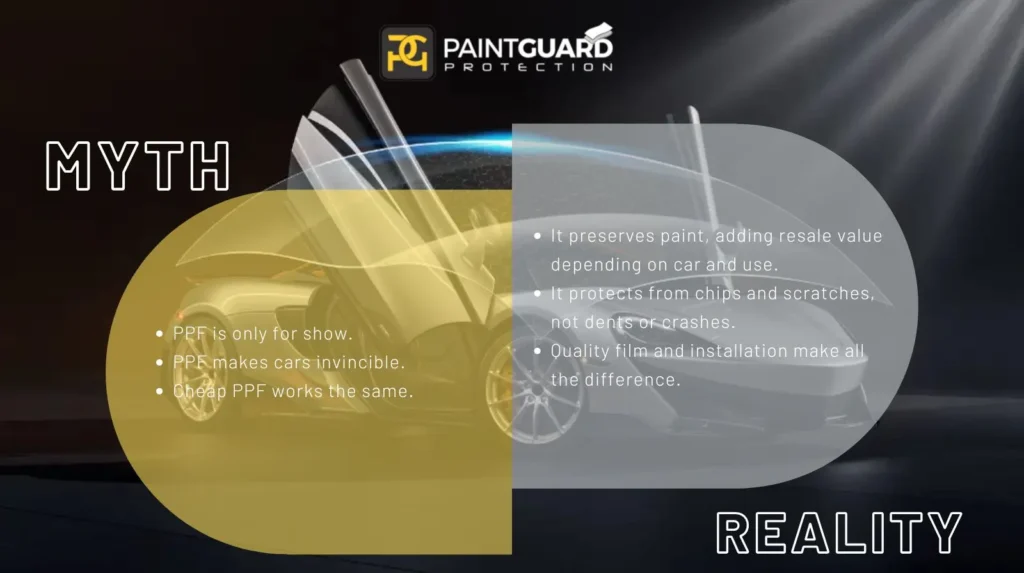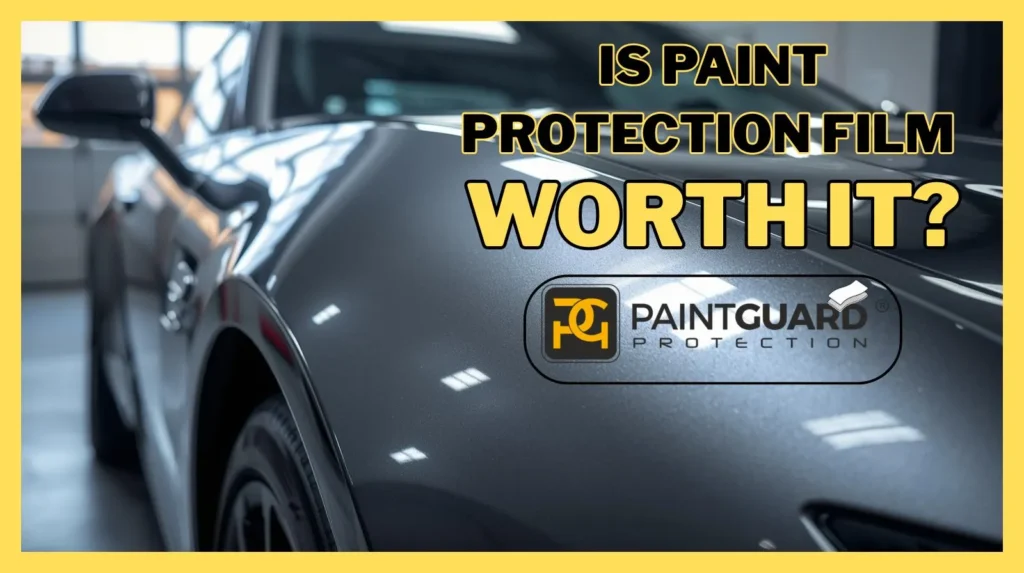You see, you have a loved car and you already realise how sad it is to find a new blemish or stone chip on your shiny paint. That is precisely where the Paint Protection Film (PPF) comes into play. It is a kind of transparent cover that will provide daily protection against wear and tear to your car.
PPF bears the impact of bird droppings to road litter and rough sunlight, so that your paint does not. Additionally, self-healing technology is incorporated into modern films, meaning that light scratches actually fade away on their own.
And the best part? You are not only insuring your car, you are insuring your investment. With a good paint job, your ride will seem newer longer and even result in a higher resale value.
So yes, when you think about it. PPF not only pay off but is a wise step to take for every person who actually cares about his or her car.
What is Paint Protection Film (PPF)?
PPF refers to a transparent, thin coating that is sprayed on the painted surfaces of a car. It has the task of safeguarding the original paint against chips, stone impacts, scratches, and UV damage. They are often mounted over high-impact zones of a car: bonnet/ hood, bumper, fenders, mirrors, and edges of lower doors. Others have additional options: self-healing minor scratches, hydrophobic (water-resistant), UV filter, and stain resistance.

What are the key Advantages of PPF?
The major benefits of applying PPF are the following and are described in a simple manner:
Scratch & Chip Protection
As you pass through roads, particularly highways or rough roads, the front end of your car (as well as the sides) is hit by stones, gravel, and small debris. PPF is a physical barrier that separates the paint and the world.
Protection against UV and Fading of Paint
Strong sunlight tends to fade and destroy paint during the time of sunlight. A good PPF prevents UV and also retards that fading/oxidation. This implies that the car paint is better maintained in a closer state of being new.
Less Complicated Cleaning and Maintenance
Due to the fact that most PPFs are hydrophobic (water-repelling) and smoother, it is not as easy to get dirt and dust on. It is easier to clean, and your car can possibly look shiny all the time.
Boosts Resale Value
When you maintain your car’s paint (fewer scratches/chips/fading), the car will look more like it is new when you sell it. Customers have a tendency to prefer vehicles that have not been spoiled or repainted. PPF can be used to maintain that state.
Peace of Mind
The most accessible advantage is sometimes psychological: you are driving and you know that your car is so well-guaranteed. That is, there is less concern over small-scale damage, chips of stones, door edges in parking lots, etc.
What Are the Cons?
Nothing is perfect. PPF has its trade-offs. Let’s break them down.
High Upfront Cost
One of the greatest grievances: It is expensive. PF (and full-body coverage in particular) is not inexpensive to install.
The thing is that now you are spending money to prevent damage in the future. That would be determined by what kind of car would make sense, your style of driving and the duration that you may own it.
Optimal use of the resource needs professional installation
The installation of a PPF well is not a simple task. When it is done incorrectly, you can get bubbles, peeling edges, lines in the film, and yellowing. So you require a reputable installer, which is an added expense.
It does not guarantee it Against All
PPF prevents scratches, chips and UV fading. However, it cannot withstand significant dents, collisions, rust or intensive physical damage. Then, when you mishandle an accident, you pay.
Limited Lifespan
PPF is permanent, though not durable. However, with time, even a good film can corrode, fester or need a replacement. Other, less expensive films can turn yellow.
So you have to think about what will happen in the year 5, year 8, etc.
Tangible Edges / Beauty Problems
In case there is coverage (say bumper + hood) of only part of the car, there may be visible film edges or a slight discrepancy. Moreover, in the case of low quality of the film, its appearance can be influenced.
Under Which Conditions Does PPF Have the Most Sense?
It is not necessarily worth it with every car and every owner of PPF. The following are the cases in which it is very prudent:
- You have an expensive brand (luxury brand, expensive original paint). It is expensive to repaint, and therefore it is justifiable to protect the paint.
- You intend to hold the car for a long period and not 1-2 years. The greater the length of time it remains, the greater the protection.
- You drive frequently through unsmooth roads, or through highways where stone-chips are prevalent, or parks in exposed/high-danger areas (finger dents in parking lots, etc.).
- You are concerned with being able to resell the car and that the car should be in a good state when you sell.
- You live in a place with high UV/sun/radiation or in an area with dust/gravel roads, where you are most likely to have paint damage.
When Might PPF Not Be Worth It?
The following are some of the scenarios where PPF can not result in a good ROI:
- The car is cheap, with cheap paint work; you think you are going to sell/replace it in 1-2 years. It might not be reasonable to spend a huge amount of money on PPF.
- The conditions of your driving are mostly safe and low-risk: indoor parking, non-rugged roads, and very little contact with debris.
- Even when you are selling, you do not care much about the state of the paint as long as you have some small bits or you have to repaint it afterwards.
- The price of PPF is very expensive compared to the value of the car, to the extent that even when it is insured, it might not be proportionate to the value.
In the case of cheaper cars, it does not pay.

Myth vs Reality
| Myth | Reality |
| PPF is only for show, doesn’t add value. | It can add value via better paint condition, but it depends on the car and usage. |
| PPF makes the car invincible. | No, it protects from certain damage (chips/scratches) but not major collisions/dents. |
| Cheaper PPF works just as well. | Not always. The quality of the film and the installer matter a lot. Poor film may yellow/peel. |
What’s the Break-Even? Does It Pay Off?
You may wonder: Am I going to get this money back by selling the car? It relies, yet there are certain figures.
The Cars in good original paint conditions can resell at 5-10 per cent higher than similar models without PPF, according to one source.
Note: That is on a fairly high-value car, which is of long-term keeping, in good condition. In case of a cheaper vehicle or when selling early, the break-even point may not occur.
Maintenance and After installation expectations
After installation of PPF, here is what you should do/ expect:
- Take a good quality car wash/cleaner. Use hard chemicals at all costs, as that destroys the film.
- Frequent washing assists in cleaning off the grit/dirt that can scratch off the film surface.
- Some expensive films can have minor scratches which can self-heal with heat should it be possible.
- After some time, examine the edges of the film: whether it begins to lift or go yellow (in case of low-quality film) you can change parts.
- When you finally repaint a panel, you will have to put film on that panel also (costs something). This is an indirect expense to some users.
Is PPF Worth It?
Yes, PPF can be worth it – but not at all. The answer with respect to your car, your collection period, your mode of usage and driving, the amount of risk your car is subjected to, and the amount of money you pay for the film and installation weight heavily.
You have a high-quality car, drive a lot, you are not worried about resale value, you want peace of mind: Get PPF.
You have a low-price car, you drive under safe/low-risk conditions, you are going to sell it in 2 years: it might not be worth covering in the full sense of the term; instead, you can use partial coverage or a good coating.

